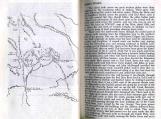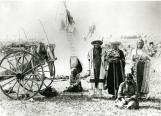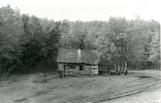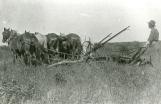1
Our story has many facets, the more indepth details of which follow in the chapters of it's history.But first, we wish to give you a rundown of the main themes of our story.
It's about the strong spirit of the early Pioneer, who paved the way for the taming of the West.
Even the 'word' "Pioneer" (in it's French origin), means "Foot Soldier" - one who goes ahead preparing the way for others to follow.
In the very early days before Mirror there were no roads, only wild, lonely trails one could walk, ride a horse, or pull a cart along. Well-worn River Cart trails crossed north to south across the east part of of area. Other side trails netted the vast prairies.
Traffic was slow, but as the trails became larger and more travelled, there was a steady flow over these endless miles of prairie. All north and south traffic to the east passed just west of Buffalo Lake, crossing the creek where Lamerton eventually was built.
Through this trail passed all the well-known figures of the day, and today this trail is Highway 21, following the old route as far as Lamerton Creek. To the west, another north/south trail larger than ours was the famous C & E Trail, used by those west of us.
The only people at first were our North American natives. Our area was along the division between the Blackfoot of the south, and the Cree of the north, and many battles were said to have been staged in our area before the settlers came. After the 1870 Riel Rebellion, many Metis in southern Manitoba moved further West, with one group settling nearby on the NW corner of Buffalo Lake.
When the trappers, hunters and missionaries arrived, each forever changed the West in their own particular way.
Trappers and hunters who came to the area for any length of time, would build small cabins to work out of. Early history records of our area show that Colonel Sam Steele, of the North West Mounted Police, found over 400 cabins on the shores of Buffalo Lake in 1875, and that there was still a herd of over 50,000 buffalo in our area at that time.
Our first NWMP post was also established in 1875 in order to protect the natives from the whiskey traders who began to devastate the native populations and families with their whiskey.
The Metis settlement on Buffalo Lake became a buffalo hunter's camp. At the beginning of the 19th Century, there were about 60 million buffalo in North America, but by 1880, the great herds of buffalo were almost wiped out all across the North American West, first by hunters, and later by disease which arrived with the first cattle.
A story tells that our earliest settler saw only 26 buffalo on Lamerton Flats in 1885, and in 1886, only 13 of those came back. In 1887, none returned.
In 1883, the surveyers made their first trip through this part of the country, charting the land for the soon to be flocks of homesteaders the government hoped to seed the land with.
Father Lacombe, one of our first missionaries, nursed a group of Blackfoot Indians through a scarlet fever epidemic on the shores of Buffalo Lake in the late 1800's.
St. Monica's church was built in 1885, in the middle of nowhere along the trail that went through to Lamerton Flats, and families from all over the area gathered there for services and social contact. By then quite a few of the 'very' early settler families had established themselves, and the area became known as the Buffalo Lake Settlement.
The story continues as the rush of homesteaders arrive, and towns begin to spring up as the railway pushes on into the territory.
The government of Canada, offering free land (homesteads) to those who would dare to adventure into this wild land to tame it, wanted to create new sources of food and supplies for both the East and to ship overseas.
Families who were struggling elsewhere for survival on the land jumped at the chance to start over in an area where the land was said to be extremely fertile and untouched.
In order to have a way to transport these food sources back to the east or onto ships for overseas, they needed to have the east and west connected by the largest source of transportation of the day, the Railway.
They offered the railways incentive to expand into the West, and the railways, needing towns along the way to supply their trains and crews with food, rest stops and repair places, in turn began to create and expand population centres along the routes they chose to build.
The Grand Trunk Pacific Railway was the one to expand into our area. It needed a Divisional point town to fill it's needs and around 1910/1911 looked at the tiny town of Lamerton as the best possibility.
Finding the best lay of land to build a roundhouse and trainyards on, they tried to purchase it from the owner at the time, Mr. Valentine Neis, very much a character and adventurer of the times.
The deal fell through, when they couldn't come to an agreement to terms for the land, and the GTP railway decided to instead build it's own town, just 2 km South of Lamerton, calling it Mirror.
They turned over the creation of Mirror to the land company, Transcontinental Townsite Co. Ltd., who purchased a large amount of land, had some of it surveyed into town lots, advertised an auction sale, where they sold most of the main town lots in 2 days, and then continued to advertise world-wide that this new town was the investment of the century, with plans for a lakeside resort.
As Mirror rose, Lamerton quickly died. Most of the businesses and population of Lamerton moved to Mirror, and it swiftly grew into a bustling town of about 1000 people, with stores and banks and street lights. It was slated to become the 'Little Chicago' of the West.
That was not to be in the end, as Prairie fires, the Flu epidemic, WW1, the depression and then WW2 took their tolls on the population and economy.
Today, Mirror still stands. Decendants of many of it's original pioneer families still live in the area and some of the original buildings are still here as well. It's tenacity and roots were strongly placed.
It is now a tiny hamlet, where people live quiet and peaceful lives, often remembering where they came from and the struggles which brought their families here into the West.
3
This is a North West Mounted Police (NWMP) map from 1888, showing the cart trails of western Canada.Lamerton was eventually built just west of Buffalo Lake's west end, right around the area where this map marks the Buffalo Lake Trading Post as being located, and Mirror would be just south of there.
The map and description of the area come from the book, "Land of the Lakes", a story of the settlement and development of the country west of Buffalo Lake.
This book, which took hundreds of hours to create, was put together by the Lamerton Historical Society in 1974, specifically for our museum to share with our viewers and audiences who wish to know more about the history of our area.
Many of the photographs in this exhibit came from the nine wonderful photo albums which accompanied this book when it was donated to our museum.
5
A Cree encampment nearby.Note the River Cart on the left.
7
Here stands Jim Gadsby's home.He was one of the first settlers in the area, and was also one of the most interesting characters of the time, even being named as attached to the Jesse James gang.
9
Valentine Neis, who because he wouldn't sell his land at Lamerton to the Grand Trunk Pacific railway, paved the way for Mirror to be born.Valentine was another of the very special characters of this area.
He was, as this business card depicts, a water locator, as well as a prospector and adventurer of all kinds. He also farmed, ran a saw mill and raised a family.
The Neis family is still strongly attached to our area and the land.
11
Lamerton was the tiny town, which died as Mirror was born.13
A typical scene from the early 1900's, on a homestead.Breaking virgin prairie land with primitive tools, brute strength and the help of your horses was very hard work, but the men of the times and their families gave it their all, and made a good life for themselves in this new land.
Everett Malott is the man in this photo.






